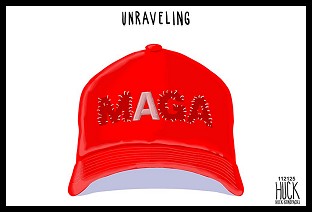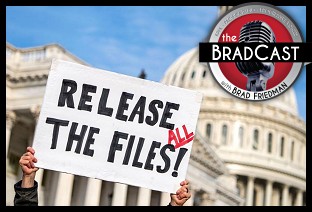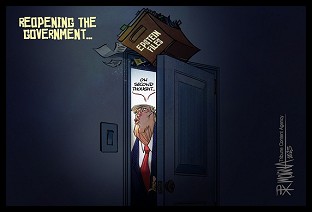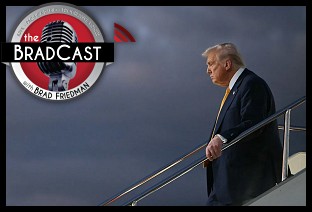READER COMMENTS ON
"Diebold's Response to Princeton Report 'Dodges' Issues, Says Computer Scientist Doug Jones"
(14 Responses so far...)
COMMENT #1 [Permalink]
...
Floridiot
said on 9/15/2006 @ 3:50 pm PT...
Yeah, and what happens when the infected machine/card gets put in the main tabulator for counting ?
I would say that every machine/card is now infected
that ever touched the 1st infected card and on down the line, like an infected floppy
And who gives a shit what SAIC has to say good or bad
a Fascist outfit if I've ever seen one
"Many SAIC officers are current or former government and military officials. Retired Army Gen. Wayne Downing, who until last summer served as chief counter-terrorism expert on the National Security Council, is a member of SAIC's board. Also on the board is former CIA Director Bobby Ray Inman, who served as director of the National Security Agency, deputy director of the CIA and vice director of the Defense Intelligence Agency. During the first Bush administration and while on the board of SAIC, Inman was a member of the National Foreign Intelligence Board, an advisory group that reports to the president and to the director of Central Intelligence"
Link
COMMENT #2 [Permalink]
...
BigJohn
said on 9/15/2006 @ 4:17 pm PT...
Oh boy - can't wait till the "advertise liberally" crowd starts spreading the word and promoting action that something be done about this [cricket chirp, cricket chirp]
COMMENT #3 [Permalink]
...
Miss Persistent
said on 9/15/2006 @ 5:21 pm PT...
Oh ya! I emailed Maryland election people yesterday about their "out of date" web information! Yeeha! Maybe I made a difference! I sent them Brad's Salon/Princeton article as the reference, used the word "conflicting". (cc'd the Governor). Then today, I emailed them additional news about same. Will do again as required.
The Washington Post did some decent coverage today on the Maryland card issue - referencing the Princeton in their article as well! I congratulate them on that. Paper and pencil would be SO simple!!
Also, per WAPO, it seems the "cards" that were missing in the Maryland Montg. Co. "materials to take to the precincts for sure" packages were not on the LIST of things to include (so THAT error goes at least one step higher up than the poor soul who is so willing to take the blame). The list really should just include: ballots, voter list, pencils. Instead, it was reported to be a 6-page list!
In addition, the Post mentioned that a Smithsonian magazine editor was disenfrachised. We have electronic poll books now too and when he got to his machine he found out that he had already voted! BAD surprise! Montgomery County IS a place where when you hear the words "some heads will roll" they WILL roll. (Albeit maybe not for the exactly correct reason - it's a start!).
I WILL keep them up-to-date . . . THANK YOU BRAD!!
COMMENT #4 [Permalink]
...
Chrisco
said on 9/15/2006 @ 6:21 pm PT...
Please don't tease me again! I've heard the MSM pick up the story a little. But I have thought that before too many times. I really hope it's true, but I'm afraid to get my hopes up too much. Either way, Brad keeps fighting for all of us, so we have to keep trying to spread the truth.
COMMENT #5 [Permalink]
...
STOP George
said on 9/15/2006 @ 7:46 pm PT...
.
.
.
I've taken the perogative to make this video go viral, so that uninformed Americans can witness how insecure the fundamental basis for their democracy really is.
Please visit this YouTube video and
- rate it
- favorite it
- link it to your blog (if you have one)
- make a comment
Here is the rankings for this video so far:
Views: 26031
#3 - Most Discussed (Today)
#1 - Most Discussed (Today) - News & Blogs
#35 - Most Discussed (This Week)
#14 - Most Discussed (This Week) - News & Blogs
#35 - Most Discussed (This Month) - News & Blogs
#11 - Top Rated (Today)
#5 - Top Rated (Today) - News & Blogs
#60 - Top Rated (This Week) - News & Blogs
#21 - Most Viewed (Today)
#4 - Most Viewed (Today) - News & Blogs
#70 - Most Viewed (This Week) - News & Blogs
#2 - Top Favorites (Today)
#1 - Top Favorites (Today) - News & Blogs
#25 - Top Favorites (This Week)
#4 - Top Favorites (This Week) - News & Blogs
#10 - Top Favorites (This Month) - News & Blogs
-------------
With 100 million hits per day, I'm trying to make this one of the most viewed videos ever on YouTube. And why the hell shouldn't it be?
Oh, and please email this link to others. Thanks!
.
.
.
COMMENT #6 [Permalink]
...
STOP George
said on 9/15/2006 @ 7:47 pm PT...
COMMENT #7 [Permalink]
...
calipendence
said on 9/15/2006 @ 8:02 pm PT...
Brad,
I did about a half hour worth of a video interview while I was in Iowa City the previous week with Doug Jones on E-voting stuff right before he had a meeting with a local voting integrity group there then on Thursday. Not this particular story then, but if you're interested, let me know. I'm going to try and digitize it sometime this weekend and maybe get it online.
In it he talks about concerns he has with offline mail-in voting like that which is done in Oregon now.
COMMENT #8 [Permalink]
...
Brad
said on 9/15/2006 @ 9:04 pm PT...
Always interested Calipendence. Moreso if you've made up a transcript to boot.
Thanks Miss Persistent for your persistance in Maryland. I promise you (as if you didn't know)that Maryland is a snakepit. Lamone is a disaster. There will be more to come.
And thank *you* StopGeorge for sending the virus video viral! 
COMMENT #9 [Permalink]
...
STOP George
said on 9/15/2006 @ 9:36 pm PT...
.
.
.
You're quite welcome, Brad!
I encourage everyone here to read some of the 400+ comments at that link as well. It is interesting to note how may people are SURPRISED that this is happening to democracy in America. We MUST spread this video far and wide!!!
There is little in the way of negative comments as well. This is, afterall, a non-partisan issue --- as you have said many times before, Brad.
.
.
.
COMMENT #10 [Permalink]
...
Miss Persistent
said on 9/16/2006 @ 7:12 am PT...
More coverage in WaPo today on Maryland's recent voting fiasco. Only one person cited in the article used the term "sour grapes." And here's a new approach, the winner in one of the PG county primaries is calling for an investigation. PG did get their voter cards but had tons of problems with the memory cards. Imagine that.
A lot to do before November! And don't think that voting by absentee ballot is a quick solution. From what I understand, wherever it is the ballots go via mail they still end up in a black box - Diebold's opscan machinery to be specific.
Question - Couldn't the same infection then stay on the machines election after election year after year? With each machine host spreading the bad code onto new memory cards and then going into new machines ad nauseum?
COMMENT #11 [Permalink]
...
ruskindoc
said on 9/16/2006 @ 9:17 am PT...
Is there anyone out there who doesn't believe that certainly the 2004 Presidential election was "stolen", thanks exclusively to Diebold, Ken Stillwell, and some other Ohio GOP frauds?? If you do, I have some swampland in Arizona to sell you!! I'd say it's a very safe assumption.
As for the 2000 allegedly "stolen election" via the state of Florida, just look who the crooks were there: Katherine Harris was Supervisor of Elections and is probably going to be indicted in the Duke Cunningham scandal (pillar of truth and honesty and "hand picked" by God??) and Brother Jebbie who was and still is Governor. Doesn't take a wizard to figure this one out as well.
Wake up American and speak out against what will be the greatest coup on the american people in our lifetimes!
COMMENT #12 [Permalink]
...
HMFWIC
said on 9/16/2006 @ 1:05 pm PT...
I wonder how long it will take for a new breed of Luddites to appear - people who will vote early to disable any and all touchscreen voting machines so paper ballots _have_ to be used instead. A hammer would work, but so would a pocket-sized Cockcroft-Walton HV generator or a tube of instant epoxy or even a judiciously applied bottle of nail polish on the touch screen ........
COMMENT #13 [Permalink]
...
Larry Bergan
said on 9/17/2006 @ 2:15 am PT...
Nice try Diebold, you're going to have to try a lot harder to debunk scientists!
COMMENT #14 [Permalink]
...
big dan
said on 9/18/2006 @ 11:18 am PT...
DIEBOLD: "A virus was introduced to a machine that is never attached to a network."
(big dan: Their answer implies that they admit a virus can be introduced. They're not denying it, just pointing out that in the test, a virus was introduced to a machine that is never attached to a network.)
DIEBOLD: "The current generation AccuVote-TS software - software that is used today on AccuVote-TS units in the United States - has the most advanced security features, including Advanced Encryption Standard 128 bit data encryption, Digitally Signed memory card data, Secure Socket Layer (SSL) data encryption for transmitted results, dynamic passwords, and more."
(big dan: This means they admit that past elections have been stolen/hacked, but now they MIGHT be safer than the elections that were hacked. They're ADMITTING elections were hacked on previously worse secure generations of their machines!)
DIEBOLD: "In addition to this extensive security, the report all but ignores physical security and election procedures. Every local jurisdiction secures its voting machines - every voting machine, not just electronic machines. Electronic machines are secured with security tape and numbered security seals that would reveal any sign of tampering."
(big dan: blackboxvoting.org has unsealed/hacked/resealed the machines undetected, and sleepovers are real secure, aren't they?)
DIEBOLD: "Secure voting equipment, proper procedures and adequate testing assure an accurate voting process that has been confirmed through numerous, stringent accuracy tests and third party security analysis."
(big dan: IE, if proper procedures ARE NOT followed, they can be hacked into. And what is meant by "adequate testing"? How about 100% testing? What the fuck does "adequate" mean???)
DIEBOLD: "Every voter in every local jurisdiction that uses the AccuVote-TS should feel secure knowing that their vote will count on Election Day."
(big dan: "LOL LOL LOL LOL LOL LOL LOL LOL LOL LOL LOL LOL LOL LOL LOL LOL LOL LOL LOL LOL LOL LOL LOL LOL LOL LOL LOL LOL LOL LOL LOL LOL LOL LOL LOL LOL LOL LOL LOL LOL LOL LOL LOL LOL LOL LOL LOL LOL LOL LOL LOL LOL LOL LOL LOL LOL LOL LOL LOL LOL LOL LOL LOL LOL LOL LOL LOL LOL LOL LOL LOL LOL LOL LOL LOL LOL LOL LOL LOL LOL LOL LOL LOL LOL LOL LOL LOL LOL LOL LOL LOL LOL LOL LOL LOL LOL LOL LOL LOL LOL LOL LOL LOL LOL LOL LOL LOL LOL LOL LOL LOL LOL LOL LOL LOL LOL LOL LOL LOL LOL LOL LOL LOL LOL LOL LOL LOL LOL LOL LOL LOL LOL LOL LOL LOL LOL LOL LOL LOL LOL LOL LOL LOL LOL LOL LOL LOL LOL LOL LOL LOL LOL LOL LOL LOL LOL LOL LOL LOL LOL LOL LOL LOL LOL LOL LOL LOL LOL LOL LOL LOL LOL LOL LOL LOL LOL LOL LOL LOL LOL LOL LOL LOL LOL LOL LOL LOL LOL LOL LOL LOL LOL LOL LOL LOL LOL LOL LOL LOL LOL LOL LOL LOL LOL LOL LOL LOL LOL LOL LOL LOL LOL LOL LOL LOL LOL LOL LOL LOL LOL LOL LOL LOL LOL LOL LOL LOL LOL LOL LOL LOL LOL LOL LOL LOL LOL LOL LOL LOL LOL LOL LOL LOL LOL LOL LOL LOL LOL LOL LOL LOL LOL LOL LOL LOL LOL "
 Noted University of Iowa computer scientist and e-voting expert, Douglas W. Jones, posted a reponse via email this morning to Diebold's official reply to Princeton University's recent report, detailing the ease with which Diebold's AccuVote touch-screen voting machine may have a virus inserted into its system.
Noted University of Iowa computer scientist and e-voting expert, Douglas W. Jones, posted a reponse via email this morning to Diebold's official reply to Princeton University's recent report, detailing the ease with which Diebold's AccuVote touch-screen voting machine may have a virus inserted into its system.

 Sunday 'Leave 'em in Stitches' Toons
Sunday 'Leave 'em in Stitches' Toons President of United States Calls for Killing Democratic Officials: 'BradCast' 11/20/25
President of United States Calls for Killing Democratic Officials: 'BradCast' 11/20/25 'Green News Report' 11/20/25
'Green News Report' 11/20/25
 Is MAGA Finally Beginning to Fall Apart?: 'BradCast' 11/19/25
Is MAGA Finally Beginning to Fall Apart?: 'BradCast' 11/19/25 Trump's Terrible, Horrible,
Trump's Terrible, Horrible, 'Green News Report' 11/18/25
'Green News Report' 11/18/25 A Kaleidoscope of Trump Corruption: 'BradCast' 11/17/25
A Kaleidoscope of Trump Corruption: 'BradCast' 11/17/25  Sunday 'Back to Business' Toons
Sunday 'Back to Business' Toons Trump DOJ Takes Stand
Trump DOJ Takes Stand 'Green News Report' 11/13/25
'Green News Report' 11/13/25 Mamdani's 'Surprisingly Affordable' Afford-ability Agenda for NYC: 'BradCast' 11/12
Mamdani's 'Surprisingly Affordable' Afford-ability Agenda for NYC: 'BradCast' 11/12 After the Shutdown and Before the Next One: 'BradCast' 11/11/25
After the Shutdown and Before the Next One: 'BradCast' 11/11/25 'Green News Report' 11/11/25
'Green News Report' 11/11/25 Victories for Democracy in Election 2025; Also: 7 Dems, 1 Indie Vote to End Shutdown in Senate: 'BradCast' 11/10/25
Victories for Democracy in Election 2025; Also: 7 Dems, 1 Indie Vote to End Shutdown in Senate: 'BradCast' 11/10/25 Sunday 'Ass Kicking' Toons
Sunday 'Ass Kicking' Toons 'We Can See Light at the End of the Tunnel' After Election 2025: 'BradCast' 11/6/25
'We Can See Light at the End of the Tunnel' After Election 2025: 'BradCast' 11/6/25 'Green News Report' 11/6/25
'Green News Report' 11/6/25 BLUE WAVE! Dems Win Everything Everywhere All at Once: 'BradCast' 11/5/25
BLUE WAVE! Dems Win Everything Everywhere All at Once: 'BradCast' 11/5/25 Repub Thuggery As Americans Vote: 'BradCast' 11/4/25
Repub Thuggery As Americans Vote: 'BradCast' 11/4/25 Last Call(s) Before Election Day 2025: 'BradCast' 11/3/25
Last Call(s) Before Election Day 2025: 'BradCast' 11/3/25 A Pretty Weak 'Strongman': 'BradCast' 10/30/25
A Pretty Weak 'Strongman': 'BradCast' 10/30/25 Proposal for 'Politically Viable Wealth Tax' Takes Shape in CA: 'BradCast' 10/29
Proposal for 'Politically Viable Wealth Tax' Takes Shape in CA: 'BradCast' 10/29 Monster Storm, Endless Wars, Gamed Elections: 'BradCast' 10/28/25
Monster Storm, Endless Wars, Gamed Elections: 'BradCast' 10/28/25 Let's Play 'Who Wants to Be a U.S. Citizen?'!: 'BradCast' 10/27/25
Let's Play 'Who Wants to Be a U.S. Citizen?'!: 'BradCast' 10/27/25 Exiled NOAA Scientists Resurrect Critical Disaster Database: 'BradCast' 10/23/25
Exiled NOAA Scientists Resurrect Critical Disaster Database: 'BradCast' 10/23/25
 VA GOP VOTER REG FRAUDSTER OFF HOOK
VA GOP VOTER REG FRAUDSTER OFF HOOK Criminal GOP Voter Registration Fraud Probe Expanding in VA
Criminal GOP Voter Registration Fraud Probe Expanding in VA DOJ PROBE SOUGHT AFTER VA ARREST
DOJ PROBE SOUGHT AFTER VA ARREST Arrest in VA: GOP Voter Reg Scandal Widens
Arrest in VA: GOP Voter Reg Scandal Widens ALL TOGETHER: ROVE, SPROUL, KOCHS, RNC
ALL TOGETHER: ROVE, SPROUL, KOCHS, RNC LATimes: RNC's 'Fired' Sproul Working for Repubs in 'as Many as 30 States'
LATimes: RNC's 'Fired' Sproul Working for Repubs in 'as Many as 30 States' 'Fired' Sproul Group 'Cloned', Still Working for Republicans in At Least 10 States
'Fired' Sproul Group 'Cloned', Still Working for Republicans in At Least 10 States FINALLY: FOX ON GOP REG FRAUD SCANDAL
FINALLY: FOX ON GOP REG FRAUD SCANDAL COLORADO FOLLOWS FLORIDA WITH GOP CRIMINAL INVESTIGATION
COLORADO FOLLOWS FLORIDA WITH GOP CRIMINAL INVESTIGATION CRIMINAL PROBE LAUNCHED INTO GOP VOTER REGISTRATION FRAUD SCANDAL IN FL
CRIMINAL PROBE LAUNCHED INTO GOP VOTER REGISTRATION FRAUD SCANDAL IN FL Brad Breaks PA Photo ID & GOP Registration Fraud Scandal News on Hartmann TV
Brad Breaks PA Photo ID & GOP Registration Fraud Scandal News on Hartmann TV  CAUGHT ON TAPE: COORDINATED NATIONWIDE GOP VOTER REG SCAM
CAUGHT ON TAPE: COORDINATED NATIONWIDE GOP VOTER REG SCAM CRIMINAL ELECTION FRAUD COMPLAINT FILED AGAINST GOP 'FRAUD' FIRM
CRIMINAL ELECTION FRAUD COMPLAINT FILED AGAINST GOP 'FRAUD' FIRM RICK SCOTT GETS ROLLED IN GOP REGISTRATION FRAUD SCANDAL
RICK SCOTT GETS ROLLED IN GOP REGISTRATION FRAUD SCANDAL VIDEO: Brad Breaks GOP Reg Fraud Scandal on Hartmann TV
VIDEO: Brad Breaks GOP Reg Fraud Scandal on Hartmann TV RNC FIRES NATIONAL VOTER REGISTRATION FIRM FOR FRAUD
RNC FIRES NATIONAL VOTER REGISTRATION FIRM FOR FRAUD EXCLUSIVE: Intvw w/ FL Official Who First Discovered GOP Reg Fraud
EXCLUSIVE: Intvw w/ FL Official Who First Discovered GOP Reg Fraud GOP REGISTRATION FRAUD FOUND IN FL
GOP REGISTRATION FRAUD FOUND IN FL

































